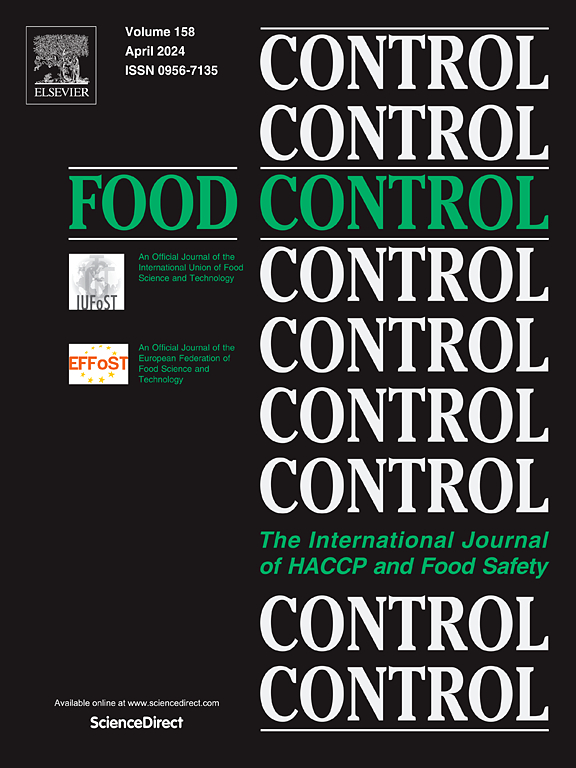The potential of energy-divergent ultrasound, slightly acidic electrolyzed water and peracetic acid in sweet potato preservation to control Rhizopus stolonifer
IF 5.6
1区 农林科学
Q1 FOOD SCIENCE & TECHNOLOGY
引用次数: 0
Abstract
Soft rot of sweet potato caused by Rhizopus stolonifer is a destructive post-harvest disease that leads to significant losses of sweet potatoes during storage. The inhibitory effects of energy-divergent ultrasound (EDU) combined with slightly acidic electrolyzed water (SAEW) and peracetic acid (PA) on R. stolonifer were investigated, to explore new methods suitable for sweet potato storage. Compared with EDU, SAEW or PA individually or combined, EDU + SAEW&PA, first treating with 70 mg/L SAEW for 2.5 min at 500 W, following by 70 mg/L PA for another 2.5 min at 500 W, completely inhibited mycelial development and spore outgrowth of R. stolonifer, resulting in severe cytoplasmic leakage. EDU + SAEW&PA also caused significant damage to the ultrastructure of R. stolonifer, increased cytomembrane permeability, collapsed mitochondrial membrane potential, and induced substantial cellular reactive oxygen species (ROS) accumulation. This effect was more pronounced compared to SAEW or PA alone. Furthermore, EDU + SAEW&PA effectively controlled R. stolonifer infection, prevented soft rot symptoms during 20 days of storage, significantly increased disease-resistance-related enzyme activities, reduced lipid peroxidation products, and preserved starch, sugar components and sweetness. Therefore, EDU + SAEW&PA could serve as an effective, environmentally friendly method to improve the storage quality of sweet potatoes.
能量发散超声、微酸性电解水和过氧乙酸在甘薯保鲜中防治匍匐茎霉的潜力
甘薯软腐病是由匍匐茎霉引起的一种具有破坏性的收获后病害,可导致甘薯在贮藏期间的重大损失。研究了能量发散超声(EDU)联合微酸性电解水(SAEW)和过氧乙酸(PA)对匍匐茎(R. stolonifer)的抑制作用,探索适合甘薯贮藏的新方法。与EDU、SAEW或PA单独或联合处理相比,EDU + SAEW&;PA先用70 mg/L SAEW在500 W下处理2.5 min,再用70 mg/L PA在500 W下处理2.5 min,完全抑制了红霉菌丝发育和孢子生长,导致严重的细胞质渗漏。EDU + SAEW&;PA对匍匐茎的超微结构也造成了明显的损伤,细胞膜通透性增加,线粒体膜电位下降,细胞活性氧(ROS)大量积累。与单独使用SAEW或PA相比,这种效果更为明显。此外,EDU + SAEW&;PA有效地控制了匍匐茎的侵染,在20 d的贮藏期间预防了软腐病症状,显著提高了抗病相关酶活性,减少了脂质过氧化产物,并保留了淀粉、糖组分和甜度。因此,EDU + SAEW&;PA可以作为一种有效的、环保的方法来提高红薯的贮藏品质。
本文章由计算机程序翻译,如有差异,请以英文原文为准。
求助全文
约1分钟内获得全文
求助全文
来源期刊

Food Control
工程技术-食品科技
CiteScore
12.20
自引率
6.70%
发文量
758
审稿时长
33 days
期刊介绍:
Food Control is an international journal that provides essential information for those involved in food safety and process control.
Food Control covers the below areas that relate to food process control or to food safety of human foods:
• Microbial food safety and antimicrobial systems
• Mycotoxins
• Hazard analysis, HACCP and food safety objectives
• Risk assessment, including microbial and chemical hazards
• Quality assurance
• Good manufacturing practices
• Food process systems design and control
• Food Packaging technology and materials in contact with foods
• Rapid methods of analysis and detection, including sensor technology
• Codes of practice, legislation and international harmonization
• Consumer issues
• Education, training and research needs.
The scope of Food Control is comprehensive and includes original research papers, authoritative reviews, short communications, comment articles that report on new developments in food control, and position papers.
 求助内容:
求助内容: 应助结果提醒方式:
应助结果提醒方式:


